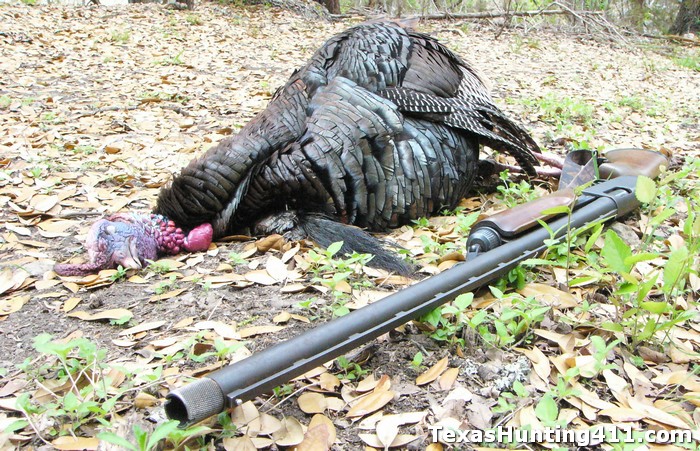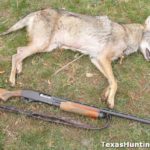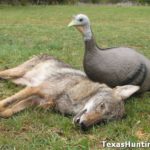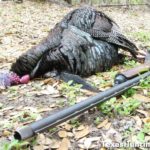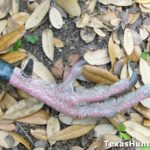When it comes to hunting, there is nothing more exciting than bringing the animals to you. Whitetail deer hunters rattle horns to bring in angry bucks looking for a fight, duck hunters enjoy using decoys to get high-flying ducks to navigate their way for a bite and turkey hunters use the lonely yelp of a hen turkey to bring in a big tom looking to put on a show. Yep, when it comes to turkey hunting, spring is the time of year when I truly get a kick out of chasing these gigantic game birds.
Spring turkey hunting is a ball when the gobblers are “hot.” Making any sound that even resembles that of a hen will result is numerous gobblers blowing up in the woods, with some probably sprinting full speed in your direction. But when the breeding is over and the turkeys turn off, the party is over for the hunters. Calls just do not get the job done. Gobblers ignore them; sometimes they even run away from them!
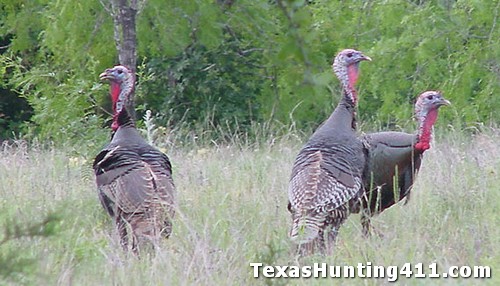
Slow. That’s how I felt this season was going to be. The breeding season in Rio Grande turkey, like other turkey subspecies, is dictated by weather conditions, which vary year to year. I was seeing a bunch of turkey activity in March, so I suspected that the spring season was going to open up too late to take advantage of hot gobblers. The spring turkey hunting season in Burnet County opened on April 2 this year, so as the opener approached I did not find myself overly excited.
But it was opening day of the spring season, so you knew I was going to be out there decked from head to toe in camoflauge and doing my best to fool an unsuspecting gobbler. The weather was a bit warm for my liking, but all systems were go as far as I was concerned. The property I hunt has a decent number of turkey on it, and they roost across the river, so there is always the possibility of running into turkey.
I walked about 400 yards from the truck to a spot that I’ve known turkey to frequent this time of year. The sun was just rising and I could see quite well. I didn’t really expect any turkey to be in the area at that point since most would still be on or close to their roosts. So on a whim, I decided to let out a few crow calls in an attempt to locate a gobbler on the off-chance that one was in the neighborhood.
Caw, caw, caw! I stood there with my shotgun over my right shoulder and my turkey hen decoy cradled in my left arm. Nothing. No shock gobbles. But it was about to get interesting. About 15 seconds after crow calling I picked up on something coming directly toward me. I stayed completely still, then noticed that it was a coyote running directly at me. It had responded to the crow call!
The coy dog was in a good trot and looking left and right, looking for the crow that had created such a disturbance. I just stood still, letting the coyote close the distance. When the critter got about 25 yards out it stopped and looked directly at me, knowing that something was wrong. I shucked the decoy that was in my left arm and grabbed my shotgun that was slung over my right shoulder. As the coyote was slanting away from right to left and looking at me I was able to put two ounces of #5 turkey load right on its numbers.
The coyote immediately hit the ground and was completely motionless within eight to ten seconds. For those that do not have any experience with turkey shot shell loads, let me just say that they are the real deal. In the past we have shot feral hogs while turkey hunting with them too, usually at five to 25 yards. I stepped the coyote off at 29 yards, easily within effective range for my 870 outfitted with an extra-full choke.
I thought the early coyote action was already worth the price of admission. By the way, I shot another coyote while turkey hunting last year as it tried to sneak up on my decoy, but it winded me on the edge of my effective range for a take-down shot. It did, however, get shot and took a good amount of lead. I did not find the animal within 100 yards, but I suspect it lived an abbreviated life.
So with a coyote down and time on my side, I decided to make my way towards the eastern edge of the property, passing by a withering winter food plot. I set up several times along to the way to do some short-distance predator calling, but nothing else responded. All the time I kept my ears opened for some gobblers talking, but nothing. I kept moving east and scouting around the property, examining some new areas.
Finally, around 10:30 in the morning I heard a faint gobble to the north. I decided to work that way, taking my time not to bust any birds along the way. After working a good half of a mile, I decided to use my crow call to see if I could locate the gobbler I had heard earlier. Immediately after crowing, a gobble came from about 200 yards away. I was in business!
I eased through the woods to a roadway that was about 30 yards away and set out my hen decoy. I backed off a found a good tree to sit up against. I called an he gobbled, again and again. For the next 45 minutes I would yelp and the tom would gobble. However, it never sounded like he was moving any closer. As is common in this situation, I figured he was with a hen, had hung up in some thick vegetation, or was just talking to me to talk. Sometimes they are strange like that.
After spending the better part of an hour waiting for this guy to make a move I decided to get a little more proactive. Besides, turkey hunting is turkey hunting, whether I am calling or stalking. I decided to cut the distance and move along the roadway toward the bird. I knew the area the gobbler was in was a bit broken, but I was pretty sure I had good habitat cover for much of the distance.
After easing, crouching and crawling my way through the woods I thought that I had to be getting close to this guy. I decided to pull my slate call out of my pack and give it a go just to get a location on this guy. Yelp, yelp, yelp. Boom, the gobbler blew up about 50 yards directly in front of me! I couldn’t see him, or he I, but he was there!
I kept straining to find him, and refrained from making even the slightest amount of movement. My eyes were scanning from behind my face mask, but there was no bird. There was one huge live oak tree about 30 yards in front of me that blocked much of my view. He had to be behind that tree. I decided to use the call to give off the slightest of purrs. I waited.
Finally, about three or 4 minutes later I saw something move through the brush. I could then make out a strutting gobbler about 45 yards away. He was not interested in me. I knew this because I then saw a hen feeding near him. But I was not worried about that. I just needed him to move about 12 yards to the west and I would have two small areas, about a foot and a half wide, to get a shot off.
I kept my eyes on the gobbler. I couldn’t cut the distance any further without risk of being spotted. Heck, I was lucky to even put myself in this position. Now it was just a matter of what he was going to do. The gobbler continued to strut left, the, right, then left, then right… you get the idea. This continued on for about 10 minutes, but the hen feeding near him never gave him the time of day.
For no reason at all, the gobbler broke strut and stood straight up as if something was wrong. I did not know what it could be, but I was about 95% sure that it was not me. Then, as luck would have it, the gobbler began trotting west. I could tell from his path that he was actually traveling closer and that he was going to intersect the two small openings! Time was of essence. He was just yards away from where I needed him to be.
Then, as quickly as the gobbler could have trotted about 10 yards he had made it to the first opening, my shotgun’s bead lined up on his head, and BOOM! The bird went down hard and fast. Within three or four seconds the bird was motionless. Direct hit! I was thrilled. I stepped off the 40 steps to the bird and was still in awe of all that had transpired. I figured it was going to be a slow day of turkey hunting, and I was right, until I was wrong.
It seemed as though spring turkey season had heated up all of a sudden. I tagged my turkey and shed my outer, long-sleeved shirt. It was about 85 degrees and already noon—time for lunch. The morning was over, and so was my day of turkey hunting. The gobbler had a 9 inch beard, 1 inch spurs and weighed 20 pounds. I had not brought a lunch, but I left with one! I guess I’ll eat the one the coyote didn’t.
